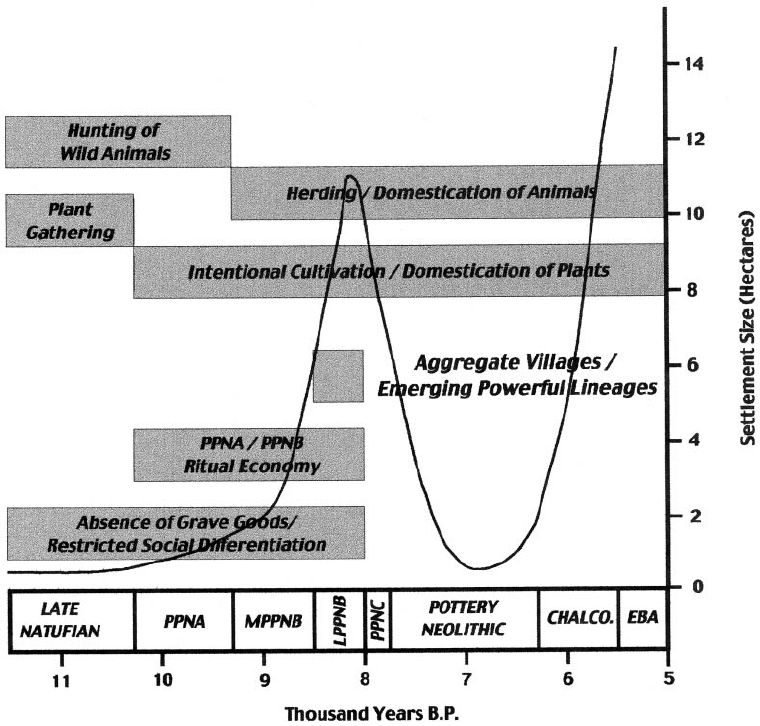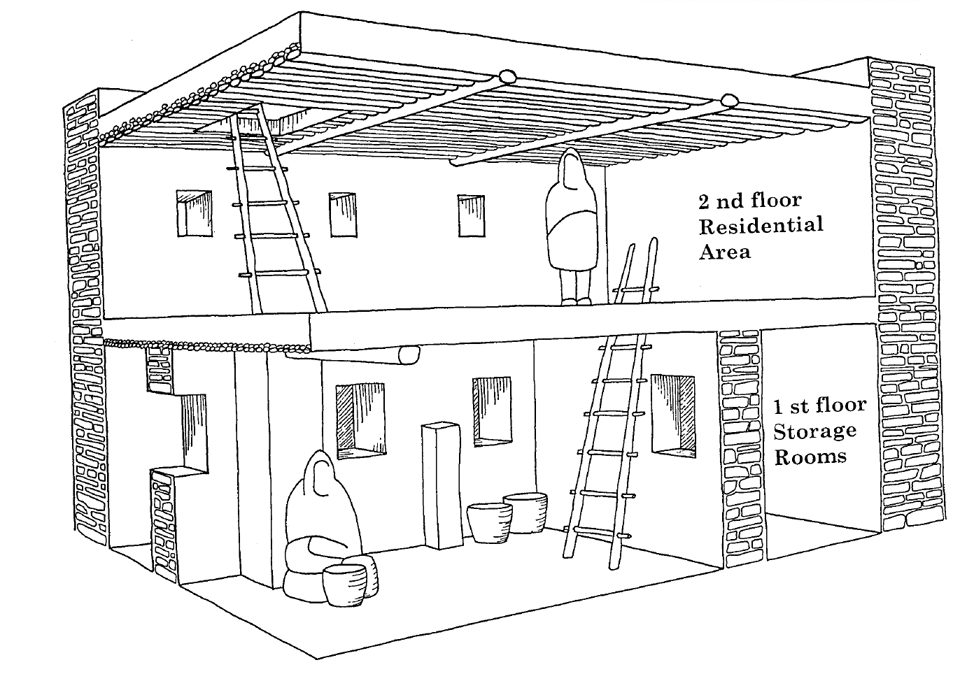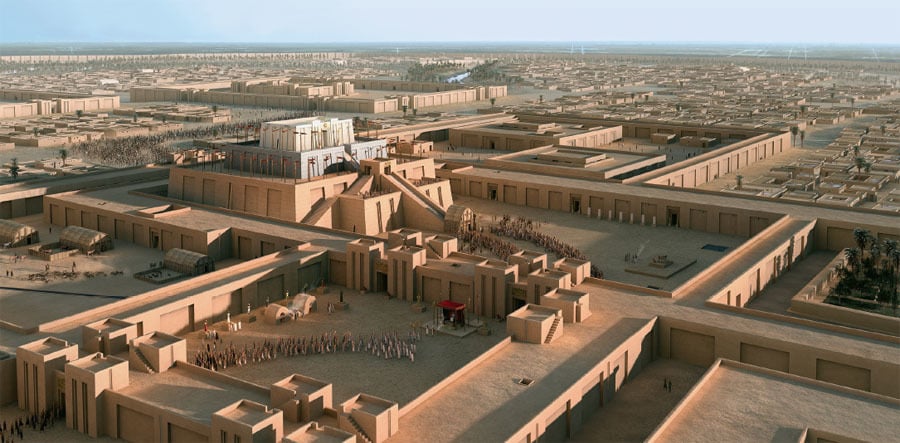There’s an odd piece of data about the late Neolithic in the Mediterranean region. Roughly 7500 years ago, during the last gasp of the stone age before we began working with metals, people abandoned their burgeoning cities and returned to small village life. Below, you can see a graph showing how the size of settlements dropped dramatically during this time.

A failed social experiment
Before we explore what caused this radical shift, let’s back up a bit. 9,000 years ago, the Levant was home to a handful of large proto-cities where thousands of residents lived cheek-to-jowl. These were high-density settlements made from mud brick and surrounded by farms. Call them the metropolises of their day. Given that most people at the time lived in nomadic groups of less than 100 individuals, we have to assume ancient urbanites led very different lives than their neighbors. They had access to a wide variety of food, art, and culture from settlers who came from far and wide, bringing their own unique traditions with them.
These Neolithic metropolises, though rare, were incredibly long-lived -- some were continuously inhabited for 2,000 years. We know of their existence because their inhabitants changed the landscape permanently, leaving dramatic hills of crumbling brick and debris behind. But then, about 7500 years ago, something changed. People abandoned their larger settlements and went back to small communities, many of them moving seasonally rather than sticking with settled, agricultural life.
Large cities didn’t re-emerge in the region for about 2,000 years. And when they did, they were shockingly different; they were essentially city-states, with kings and taxes and slaves.

So what happened? University of Notre Dame anthropologist Ian Kuijt describes these abandonments as a "failure of the neolithic experiment." He tells the story of a Neolithic proto-city he’s explored called Basta, located in what is now Jordan. Over the centuries, Basta grew larger than other villages around it. Its residents responded to the population boom by building second floors on their homes, and eventually subdividing their rooms into smaller and smaller spaces. It was as if they didn’t have the resources to build a city that gave its residents both space and privacy.
He writes:
Available architectural and settlement data illustrate a progressive growth in crowding stress ... creating social congestion, perceived loss of control over one’s immediate environment, and an overall reduction in privacy, all of which encourage people to segment their physical space.
And this isn’t just a Levantine phenomenon. We see similar patterns in the urban histories of Europe, Asia and the Americas too. There appears to be no environmental cause, at least in the case of Basta and nearby cities. Archaeologists have shown that Neolithic city people changed their diets to cope with shifts in climate, but did not abandon their homes.
Another possibility is that high-density, low-sanitation environments spawned epidemics that decimated Neolithic urban populations. Certainly there must have been plagues, but that still wouldn’t explain the widespread rejection of city life everywhere. After all, we are witnessing a pandemic right now that has yet to cause significant urban flight (though there were some false alarms about that in mid-2020), and many of our modern cities have survived epidemics over the past 2,000 years.
Kuijt’s hypothesis is that the problem was largely social. He writes:
I believe that the emergence of more powerful lineages, as well as increased social stresses related to crowding and information exchange, limited the practical ability for the community to participate in communal rituals.
Let’s unpack what Kuijt is saying here. First, he notes that “more powerful lineages,” or elites, had emerged in these cities — these would have been community leaders who helped organize everything from feasts to harvests. At the same time, social cohesion was suffering due to the population explosion, which led to increased segmentation (literally, in the case of architecture) and the usual communication mishaps that occur in large groups. With all these difficulties came the loss of public events that could include everyone in the community.
It’s the end of “communal rituals,” writes Kuijt, that sounded the death knell. As society fractured, people grew disenchanted with the “powerful lineages” who led the old rituals. Without faith in leadership and each other, urbanites saw no reason to say. Ultimately this was a failure of public institutions.

It’s worth recalling that when cities did reemerge thousands of years later, they looked absolutely nothing like those Neolithic proto-cities. They were the classic ancient cities of Mesopotamia such as Uruk, with its massive ziggurats, a financial system based on writing, and specialized labor forces. Most importantly, they were what Yale University agricultural historian James C. Scott identifies as “states.” Humans didn’t return to cities until they had invented a new social system, the state, which could organize urbanites using force, economic persuasion, or both.
The Neolithic internet
Now we can jump forward 5,000 years, to another potentially doomed experiment in community building. As you may have noticed, humans today are engaging in communal rituals on the internet using social media, games, and even plain old vanilla e-mail. During the past forty-ish years of public internet access, we’ve witnessed many of the same troubles that our Neolithic ancestors faced when they built their first proto-cities.
Online spaces started with the equivalent of villages -- BBSes, early AOL chat rooms, Usenet -- and quickly boomed into sprawling mega-sites like Facebook and YouTube. Soon the online generations grew disenchanted with business leaders and engineers regulating those sites, and we began to segment ourselves. Just like Neolithic urbanites at Basta adding more walls to create privacy, we made encrypted meeting places like WhatsApp.
Apps devoted to smaller community rituals also grew popular. There was Discord for fun and Slack for work; Clubhouse for elites and Reddit for ordinary people; Twitter for libertarians and Parler for authoritarians.
Alarmed by our loss of privacy and control online, we’ve bricked ourselves into tiny rooms. Social problems online spilled over into real-world politics. Social media propaganda influenced the outcome of elections, and closed regimes used Facebook posts to target anyone protesting local leadership.
The results? In 2018, a Pew Research survey found that 44 percent of Americans were taking a break from Facebook, and 26 percent had deleted it altogether. In 2020, advertisers began to abandon the mega-site too. And who could forget the dramatic rise and fall of other experiments like MySpace, as well as the embarrassing fate of Google+?
That said, there is still population growth on video meme machine TikTok, and tellingly TikTok is also one of the few sites that hosts public rituals that it feels like anyone can participate in (think sea shanties). Twitch, the streaming platform, is also growing -- perhaps because it, too, can broadcast its rituals live to a mass audience.
Consider that this moment might be equivalent to the late Neolithic in terms of communications technologies. Humans spent millennia using paintings and writing to pass their thoughts along to people they would never meet. Now, in the past two centuries, we’re seeing the very beginning of where new tools like the telegraph, the telephone, and the radio will lead us.
We’re building technologies that are supposed foster bigger, more complex communities, but instead they are leading us into mistrust, privacy invasion, fragmentation, and loss of shared public rituals. If the failed Neolithic experiment tells us anything, it’s that humanity has been here before. Sometimes we build amazing places, only to abandon them. That’s why I won’t be surprised if the internet is dead in less than a century. After all, one of the most popular topics of conversation online is how to stop being online.
Perhaps, in another few hundred years — or a thousand, or three thousand — the internet will return in a form we can only guess at. Our societies themselves will have to evolve before we figure out how to live with billions of people crammed into one densely-packed cyberspace.
My new book is Four Lost Cities: A Secret History of the Urban Age. You can find information and ordering links for it and my other books on my website, helpfully organized into science fiction and journalism. You can also follow me on Twitter or Instagram — or listen to Our Opinions Are Correct, the fortnightly podcast I co-host with Charlie Jane Anders. If someone forwarded this email to you, you can subscribe to it here.
You just read issue #19 of The Hypothesis. You can also browse the full archives of this newsletter.